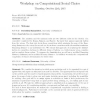Free Online Productivity Tools
i2Speak
i2Symbol
i2OCR
iTex2Img
iWeb2Print
iWeb2Shot
i2Type
iPdf2Split
iPdf2Merge
i2Bopomofo
i2Arabic
i2Style
i2Image
i2PDF
iLatex2Rtf
Sci2ools
ALDT
2015
Springer
2015
Springer
Group Activity Selection from Ordinal Preferences
: The minisum and the minimax rules are two different rules for the election of a committee considered by Brams, Kilgour, and Sanver. As input they assume approval ballots from the voters. The first rule elects those committees which minimize the sum of the Hamming distances to the votes, the second one elects those committees with the smallest maximum Hamming distance to an individual vote. We extend this approach of measuring the dissatisfaction in committee elections to different forms of ballots, i.e., trichotomous votes, complete and incomplete linear orders. To measure the dissatisfaction we will use a modified Hamming distance, ranksums, and a modified Kemeny distance. In addition we study the computational complexity of winner determination for these rules. 9:50–10:10 Andreas Darmann, University of Graz Group activity selection from ordinal preferences : We consider the situation in which group activities need to be organized for a set of agents when each agent can take ...
ALDT 2015 | Algorithms |
| Added | 15 Apr 2016 |
| Updated | 15 Apr 2016 |
| Type | Journal |
| Year | 2015 |
| Where | ALDT |
| Authors | Andreas Darmann |
Comments (0)

